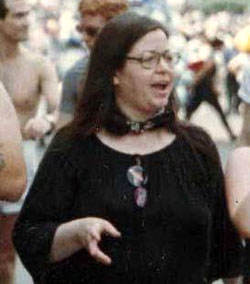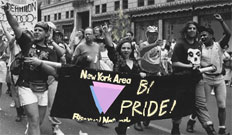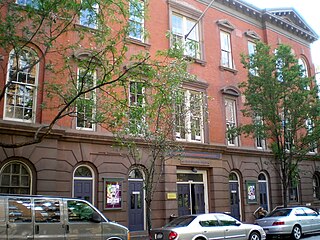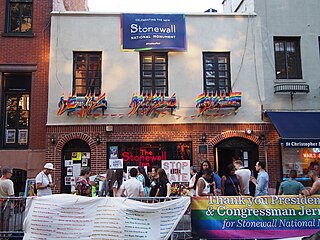Bialogue, a portmanteau of the words bisexual and dialogue , is an American activist group that started in New York City, working on issues of local, national, and international interest to the bisexual, fluid, pansexual, queer-identified communities and their allies. [1] [2] Bialogue's mission is to dispel myths and stereotypes about bisexuality, address biphobia and bisexual erasure, educate the public on the facts and realities of bisexuality and advocate for the bisexual community. Its slogan is "Taking Action not just Offense". [3]
Bialogue was founded in 2005 and is the merger of two older New York City–based activist/political groups: BiPAC and the Coalition for Unity and Inclusion. [4]
Founded in 1989, BiPAC (short for the "Bisexual Political Action Committee") was an explicitly militant activist political group dedicated to confronting and eradicating biphobia and bisexual erasure. In addition to working on issues exclusive to New York City bisexual community, BiPAC also worked in conjunction with other New York City LGBTQ and progressive groups of their day including ACT UP, Queer Nation, Irish Lesbian and Gay Organization, Children of the Rainbow, Por Los Niños, and the Coalition for a District Alternative (CoDA).
The Coalition for Unity and Inclusion (founded in 2000) was a coalition of bisexual and transgender activists who drew support from reform-minded directors of the more traditional LGBT organizations, liberal politicians as well as the grassroots bisexual and transgender community. They used such tactics as letter writing campaigns, petition drives and an innovative "feedback campaign" to achieve their goals. [4]
The original impetus for founding both BiPAC and the Coalition for Unity and Inclusion was to combat instances of blatant biphobia within the larger New York City LGBT community. Bialogue, which emerged in response to the flap [5] over the 'Bailey Study' which attempted to invalidate bisexuality itself, [6] [ verification needed ][ unreliable source? ] has always worked closely with such established bisexual organizations as BiNet USA, [7] the Bisexual Foundation [8] and the Bisexual Resource Center as well as mainstream LGBT groups such as GLAAD. [9]

Pansexuality is sexual, romantic, or emotional attraction towards people of all genders, or regardless of their sex or gender identity. Pansexual people may refer to themselves as gender-blind, asserting that gender and sex are not determining factors in their romantic or sexual attraction to others.

Biphobia is aversion toward bisexuality or people who are identified or perceived as being bisexual. Similarly to homophobia, it refers to hatred and prejudice specifically against those identified or perceived as being in the bisexual community. It can take the form of denial that bisexuality is a genuine sexual orientation, or of negative stereotypes about people who are bisexual. Other forms of biphobia include bisexual erasure.

BiNet USA was an American national nonprofit bisexual community whose mission was to "facilitate the development of a cohesive network of bisexual communities, promote bisexual visibility, and collect and distribute educational information regarding bisexuality. Until 2020, BiNet USA provided a national network for bisexual organizations and individuals across the United States, and encouraged participation and organizing on local and national levels." They claimed to be the oldest national bisexuality organization in the United States. In 2020, all of the content on BiNet USA's website was replaced with a statement that the BiNet USA president, Faith Cheltenham, now identified as Christian conservative and was walking away from progressive politics entirely.

LGBTQ culture is a culture shared by lesbian, gay, bisexual, transgender, and queer individuals. It is sometimes referred to as queer culture, while the term gay culture may be used to mean either "LGBT culture" or homosexual culture specifically.

Brenda Howard was an American bisexual rights activist and sex-positive feminist. The Brenda Howard Memorial Award is named for her.

New York Area Bisexual Network (NYABN) is a central communications network for bisexual and bi-friendly groups and resources in the five boroughs of New York City and the surrounding Tri-State area. The mission of the New York Area Bisexual Network is to facilitate the development of a cohesive bisexual community in the New York Area. The network promotes bisexual visibility, works to protect the bisexual community from discrimination and biphobia and assists and empowers the individual community members, their families and friends to live full, rich, safe and happy lives.

The Bisexual Resource Center (BRC) is a 501(c)(3) non-profit educational organization headquartered in Boston, Massachusetts, that has served the bisexual community since 1985. Originally known as The East Coast Bisexual Network, it incorporated in 1989 as a 501(c)(3) nonprofit and changed its name to the Bisexual Resource Center in 1993.
The bisexual community, also known as the bi+, m-spec, bisexual/pansexual, or bi/pan/fluid community, includes members of the LGBT community who identify as bisexual, pansexual, omnisexual, polysexual and sexually fluid. As opposed to hetero- or homosexual people, people in the bisexual community experience attraction to more than one gender.

The Lesbian, Gay, Bisexual & Transgender Community Center, commonly called The Center, is a nonprofit organization serving the lesbian, gay, bisexual and transgender (LGBTQ) population of New York City and nearby communities.
Sheela Lambert (1956-2024), a native and lifelong resident of New York City, was an American bisexual activist and writer.

Robyn Ochs is an American bisexual activist, professional speaker, and workshop leader. Her primary fields of interest are gender, sexuality, identity, and coalition building. She is the editor of the Bisexual Resource Guide, Bi Women Quarterly, and the anthology Getting Bi: Voices of Bisexuals Around the World. Ochs, along with Professor Herukhuti, co-edited the anthology Recognize: The Voices of Bisexual Men.

Celebrate Bisexuality Day is observed annually on September 23 to recognize and celebrate bisexual people, the bisexual community, and the history of bisexuality.

Bisexual erasure, also called bisexual invisibility, is the tendency to ignore, remove, falsify, or re-explain evidence of bisexuality in history, academia, the news media, and other primary sources.

LGBT movements in the United States comprise an interwoven history of lesbian, gay, bisexual, transgender and allied social movements in the United States of America, beginning in the early 20th century. A commonly stated goal among these movements is social equality for LGBT people. Some have also focused on building LGBT communities or worked towards liberation for the broader society from biphobia, homophobia, and transphobia. LGBT movements organized today are made up of a wide range of political activism and cultural activity, including lobbying, street marches, social groups, media, art, and research. Sociologist Mary Bernstein writes: "For the lesbian and gay movement, then, cultural goals include challenging dominant constructions of masculinity and femininity, homophobia, and the primacy of the gendered heterosexual nuclear family (heteronormativity). Political goals include changing laws and policies in order to gain new rights, benefits, and protections from harm." Bernstein emphasizes that activists seek both types of goals in both the civil and political spheres.

The first English-language use of the word "bisexual" to refer to sexual orientation occurred in 1892.

The following outline offers an overview and guide to LGBTQ topics:
Queer erasure refers to the tendency to intentionally or unintentionally remove LGBT groups or people from record, or downplay their significance, which includes lesbian, gay, bisexual, transgender, and queer people. This erasure can be found in a number of written and oral texts, including popular and scholarly texts.

The history of bisexuality concerns the history of the bisexual sexual orientation. Ancient and medieval history of bisexuality, when the term did not exist as such, consists of anecdotes of sexual behaviour and relationships between people of the same and different sexes. A modern definition of bisexuality began to take shape in the mid-19th century within three interconnected domains of knowledge: biology, psychology and sexuality. In modern Western culture, the term bisexual was first defined in a binary approach as a person with romantic or sexual attraction to both men and women. The term bisexual is defined later in the 20th century as a person who is sexually and/or romantically attracted to both males and females, or as a person who is sexually and/or romantically attracted to people regardless of sex or gender identity, which is sometimes termed pansexuality.